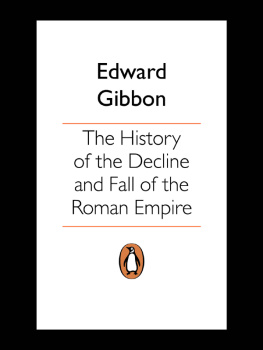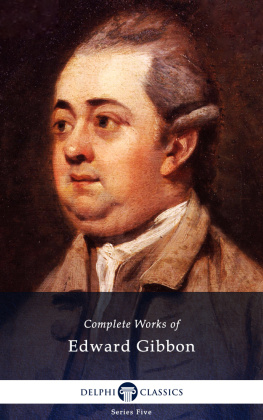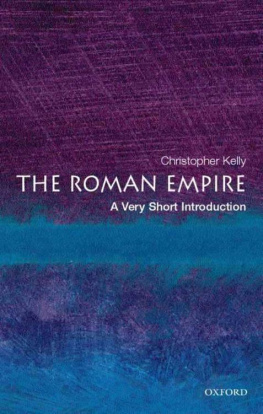
MEMOIRS OF MY LIFE
EDWARD GIBBON was born in 1737, in Putney, and was the only child of his parents to survive infancy. Although his education was frequently interrupted by ill health, his knowledge was far-reaching. His brief career as an undergraduate at Magdalen College, Oxford, ended when he joined the Catholic Church. His father sent him to Lausanne, in Switzerland, where, while studying Greek and French for the next five years, he rejoined the Protestant Church. In 1761 he published his Essai sur ltude de la littrature; the English version appeared in 1764. Meanwhile, Gibbon served as a captain in the Hampshire Militia until 1763, when he returned to the Continent. It was while he was in Rome in 1764 that he first conceived the work that was eventually to become The History of the Decline and Fall of the Roman Empire. After the death of his father, Gibbon settled in London and in 1774 was elected to Parliament where he sat for the next eight years, although he never once spoke in the Commons. He also took his place among the literary circles of London. The first volume of his famous History was published in 1776; it was highly praised for its learning and style but incurred some censure for its treatment of the early Christians. The second and third volumes appeared in 1781 and the final three, which were written in Lausanne, in 1788. He died while on a visit to his friend, Lord Sheffield, who posthumously edited Gibbons autobiographical papers and published them in 1796.
BETTY RADICE read classics at Oxford then married and, in the intervals of bringing up a family, tutored in classics, philosophy and English. She became joint editor of the Penguin Classics in 1964. As well as editing the translation of Livys The War with Hannibal she translated Livys Rome and Italy, the Latin comedies of Terence, Plinys Letters and The Letters of Abelard and Heloise, and also wrote the introduction to The Odes and Epodes by Horace, all for the Penguin Classics. She also translated from Italian, Renaissance Latin and Greek for the Officina Bodoni of Verona. She collaborated as a translator in the Collected Works of Erasmus and was the author of the Penguin reference book Whos Who in the Ancient World. She was an honorary fellow of St Hildas College, Oxford. Betty Radice died in 1985.
EDWARD GIBBON
Memoirs of My Life
Edited with an Introduction by
BETTY RADICE
PENGUIN BOOKS
PENGUIN BOOKS
Published by the Penguin Group
Penguin Books Ltd, 80 Strand, London WC2R 0RL , England
Penguin Group (USA) Inc., 375 Hudson Street, New York, New York 10014, USA
Penguin Group (Canada), 90 Eglinton Avenue East, Suite 700, Toronto, Ontario, Canada MP 4 2Y 3 (a division of Pearson Penguin Canada Inc.)
Penguin Ireland, 25 St Stephens Green, Dublin 2, Ireland (a division of Penguin Books Ltd)
Penguin Group (Australia), 250 Camberwell Road, Camberwell, Victoria 3124, Australia (a division of Pearson Australia Group Pty Ltd)
Penguin Books India Pvt Ltd, 11 Community Centre, Panchsheel Park, New Delhi 110 017, India
Penguin Group (NZ), cnr Airborne and Rosedale Roads, Albany, Auckland 1310, New Zealand (a division of Pearson New Zealand Ltd)
Penguin Books (South Africa) (Pty) Ltd, 24 Sturdee Avenue, Rosebank, Johannesburg 2196, South Africa
Penguin Books Ltd, Registered Offices: 80 Strand, London WC2R 0RL , England
www.penguin.com
Published in Penguin English Library 1984
Published in Penguin Classics 2006
Introduction and editorial material copyright Betty Radice, 1984
All rights reserved
The moral right of the author has been asserted
Except in the United States of America, this book is sold subject to the condition that it shall not, by way of trade or otherwise, be lent, re-sold, hired out, or otherwise circulated without the publishers prior consent in any form of binding or cover other than that in which it is published and without a similar condition including this condition being imposed on the subsequent purchaser
ISBN: 9781101493854
CONTENTS

PREFACE AND ACKNOWLEDGEMENTS

The text of this edition of Edward Gibbons Memoirs of My Life is based on G. A. Bonnards arrangement of the drafts Gibbon left unfinished, but with a major difference. His was a text which meticulously reproduced Gibbons uncorrected manuscripts. I have tried to standardize the punctuation and the variable use of capitals, and to follow conventions in italicizing names of books and foreign quotations and in abbreviations (M. for Monsieur, not Gibbons Mr), while adding (or correcting) accents on French words and putting breathings and accents on Greek quotations. I have also divided long continuous passages into shorter paragraphs, and made some changes in Gibbons spelling, which can be idiosyncratic and influenced by French forms. Rightly or wrongly, I hope by so doing to remove any feeling of outmoded quaintness from what is so candid and direct a work; and to break down any further barriers between Gibbon and his modern readers I have provided translations in notes of all his quotations from French, Greek and Latin.
I have drawn on Bonnards notes, many of which are simple directions to the standard reference books, as well as on the editions of Gibbons other works listed in the Bibliography, but the notes are my own. In attempting to solve the problem of the great numbers of persons and authors cited by Gibbon, I have put their names in a comprehensive index; though I have not included all the details of ). Many of the authors and their works feature in the footnotes to The Decline and Fall of the Roman Empire.
My thanks for encouragement and help on special points are to Mrs Gwynydd Gosling and the library of the Highgate Literary and Scientific Institution, Dr Colin Kolbert, Lieutenant-Colonel Patrick OKelly de Conejera, I. de Lisle Radice, Dr P. J. S. Whitmore and L. P. Wilkinson.
EDITORS INTRODUCTION

On 27 June 1787, Edward Gibbon wrote the last sentence of the sixth and final volume of The Decline and Fall of the Roman Empire:
It was among the ruins of the Capitol that I first conceived the idea of a work which has amused and exercised near twenty years of my life, and which, however inadequate to my own wishes, I finally deliver to the curiosity and candour of the public.
Nearly four years later he recalled the details: the time, between eleven and midnight; the scene, the summer-house in his garden by Lake Leman; his emotions, as he laid down his pen and paced the acacia walk joy at recovering his freedom, satisfaction at the prospect of fame, mixed with sober melancholy at having taken everlasting leave of an old and agreeable companion, and the thought that at the age of fifty the best part of his life was over.
He was in fact to live another six and a half years, but felt no great urge to embark on further large-scale writing. Some essays survive, but there was much to distract him from concentrated application. He was rich and famous, with a wide circle of correspondents; he led a full social life in Lausanne, and entertained an increasing number of visitors as the refugees from the Revolution arrived from France. He also returned from a year (July 1787 to July 1788) spent in England arranging for the publication of his final three volumes, to find that Georges Deyverdun, the friend of thirty years whose house he shared, had suffered a series of strokes. Deyverdun lingered on for a year, during which Gibbon found it impossible to recover his studious ardour, and his bereavement was keenly felt for some time. Moreover, though Gibbons mental energy never seriously flagged and he always insisted that his health was generally good, his friends were increasingly worried about his unhealthy corpulence and the plainly visible rupture or hydrocele which he was still determined to ignore. His letters also mention severe attacks of erysipelas in 1790, and another crippling bout of his old enemy, gout.
Next page






